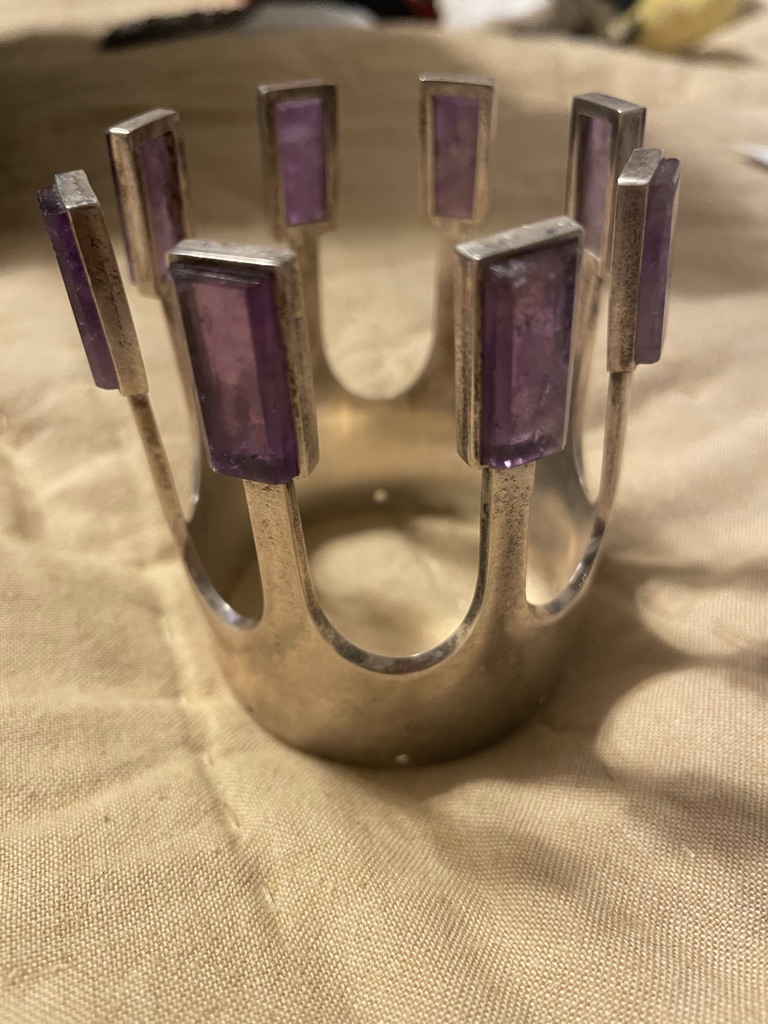Text:
KT: “This is a wedding tradition that mostly comes from my dad’s side of the family [Irish heritage], but I did it at my wedding and I believe my mother did it at her and my father’s wedding too. So, after me and your dad left the church, all the guests rang little silver bells that were passed out before the ceremony. Bells are said to ward off evil spirits and bring good luck in a marriage. They also rang the church bells too if I remember correctly, which is pretty normal for church weddings. The guests got to keep the bells and they rang them as we can in for the reception too which was really pretty. I really liked that.”
Me: “Where did you learn about this wedding tradition?”
KT: “I learned about it from my parents, I think. Like I said, I think they did something similar at their wedding. Your grandmother isn’t Irish, but your grandfather is, so they incorporated some Irish traditions into the wedding. I think he must have learned it from his family because I think I remember my mom saying my uncle did the same thing at his wedding too.”
Me: “Do you know what generation American you are?”
KT: “Yes, so my dad’s dad came from Ireland. That means my grandfather and grandmother, which would make me a 2nd generation American, I think. So, I guess that tradition is probably pretty popular in Ireland, at least in our family. I don’t know anyone in Ireland, from our family or otherwise, so I don’t really know. It’s funny too because I don’t think my sister or brother did it at their ceremonies, I can’t really remember, but they both got married first, and my mother was insistent that I do it. My dad passed when I was three months old, but you know, my mom remarried, so I was the last of her kids from my real dad. I think that’s why she really wanted me to do it since I was the last one from that side of the family.
Me: “Did you incorporate any other family or cultural traditions into your wedding?”
KT: “Well we had a Catholic wedding ceremony, which has specific things to complete the Sacrament of Matrimony. I don’t know if we really have any other specific family traditions. Well, I guess besides the bells, that’s kind of a tradition now.”
Me: “Did it feel important to connect to your Irish heritage, and in a way your dad?”
KT: “Yeah, it was nice. I never really knew him, only my stepfather, so doing something like that I like to think my dad would have appreciated it. My stepfather was Irish too, so we still did a lot of Irish things and such growing up, but it was special because my real dad did it at his wedding.”
Context: KT is a 59 year old from California. She is of Irish decent. This wedding celebration was passed down to her from her parents, and she is unsure of how far back the tradition goes in her family, but it is a very popular wedding tradition in Ireland. She told me this story in-person, and I recorded it to transcribe.
Analysis: This is a relatively common Irish tradition, one that has influence in even non-Irish weddings. As my informant mentioned, even churches for non-Irish ceremonies have a practice of ringing the church bells after the ceremony is concluded. This Irish tradition has been acculturated into a religious tradition as well, in part, likely due to the strong religious ties in Ireland. This practice is directly linked to folk legends of fairies and spirits in Ireland, as the bells are to ward off evil spirits that could cause strife for the celebrations or the new couple. It is also important to note that this tradition was encouraged by KT’s mother to connect KT to her heritage and her father, even though it is not a practice from her culture [KT’s mother is Russian]. She wanted KT to connect to her culture and the important cultural practices. It was also a way that KT was able to remember her father and have a link to him on a very important day in her life, one that is centered around family. KT also mentions that she got married in a Catholic church, and in doing so, took part in the Sacrament of Matrimony. This is a religious tradition, which has its own set of specific rites that are completed. To receive this sacrament, certain things must be completed by the bride and groom, no matter what cultural background they are from, since it is purely religious in nature.


